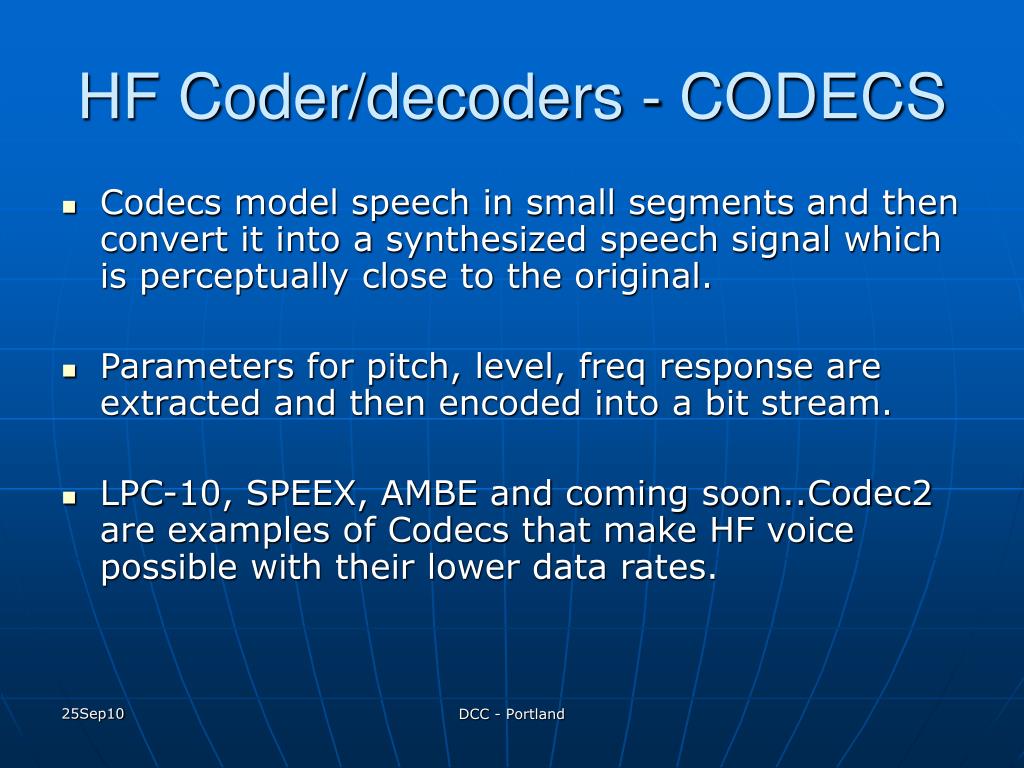

- #Ambe codec software free how to#
- #Ambe codec software free code#
- #Ambe codec software free plus#
- #Ambe codec software free professional#
RTL-SDR, are known to many now, and having to have a hardware dongle to do the
#Ambe codec software free plus#
Was likely a foreign concept to many 20 plus years ago when this problem wasįirst brought to our awareness. The USRP, HackRF, HamShield,
#Ambe codec software free how to#
We haven't yet figured out how to re-write a radio'sįirmware to create that elusive digital radio that can do more than oneĭigital mode. The hobby can use a lot more of this and a lot more people like There have only been a few radio firmware reverse engineeringĮfforts. Rather than the antique approach of shelling out hundreds of dollars for a new piece of hardware. It's a shame, and down right stupid that we cannot have hardware to be able Ham radio has a heck of a lot of talented software coders asĮvident by the 1000's of projects on github. Pretty much Every other consumer electronics item is updateable to some extent.
#Ambe codec software free professional#
Home-grade router all the functionality of a $600 Cisco professional router. In short, due to open source, one can load a third party firmware on the router and give a $60 consumer Spawned a handful of open source firmware projects for the WRT54G that extend its capabilities, and reliability, far beyond what is expected from a cheap consumer-grade router.
#Ambe codec software free code#
With the code in hand, developers learned exactly how to talk to the hardware inside and how to code any features the hardware could support. Manufacturers to release the source code. Linux components, which are covered by the GPL. History here was the original factory firmware was discovered to be based on The Linksys WRT54G WiFi router of the early 2000's was a goodĮxample of the good that can come from open firmware/open source. Let's take a quick look at why this would be good for the hobby. Gave some time ago, did also stress the need to have open radio firmware.

“this far, no further!”, that you are not permitted to create your own radio for. Why even bother with a hobby of sharing and learning, if there’s a big wall saying Where you just buy and are a passive consumer. So while D-Star was interesting as it was a new thing to playĪnd learn about when it came about, there was this "black box" aspect Closed source applications such as Dplus, Hamvoip,ĭon't contribute to the advancement of the radio art because they retard people from In order to learn we must be able to inspect to tinker, or at the very least have access to a specification To understand how it works, and maybe even build or modify your own equipment. To learn about radio, propagation, and the electromagnetic spectrum in general.

First you have to take a larger look at the point of amateur Their work, to work out an agreement so the software folks receive more thanįor many hams these days the AMBE concern is not well And when the hardware manufacturers see the potential from It's also important for leaders to recognize the works of the dedicated softwareĭevelopers. So all you need the manufacturers for is to make general purpose SDR hardware, which is an easier sell than some new special mode. Fortunately, much of the innovation now is purely in the form of software, which is much easier to mass-produce than hardware. They don't want to invest in anything unless they know it's going to sell. Manufacturers are a fairly conservative bunch. The M17 Project, but its too early to tell Newradio initiative in Germany/Austria, and so on. Holdings DV4 Mobile, the HT of the Future (aka: Algoram, Katena, Whitebox), the Keen observers have noticed a number of good radio initiatives With open firmware where we could load our own apps or alterative codec. Codec2/FreeDV is a good conception, but it hasn'tĬome to fruition in the advent of the AMBE patents expiring and other digital radios alsoĮmploying AMBE and flooding the market. There is a working implementation for HF. However, none of these digital modes have a means to specify or differentiate theĪudio codec should they ever want to move away from AMBE. The proposed solution has been to replace this with an open source codec. It's since been compounded by DMR, Yaesu Fusion, and other digital Introduced to ham radio in the late 90's earlyĢ000's. (speech coder) problem started when D-Star was developed and


 0 kommentar(er)
0 kommentar(er)
